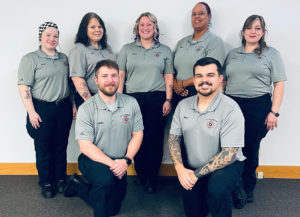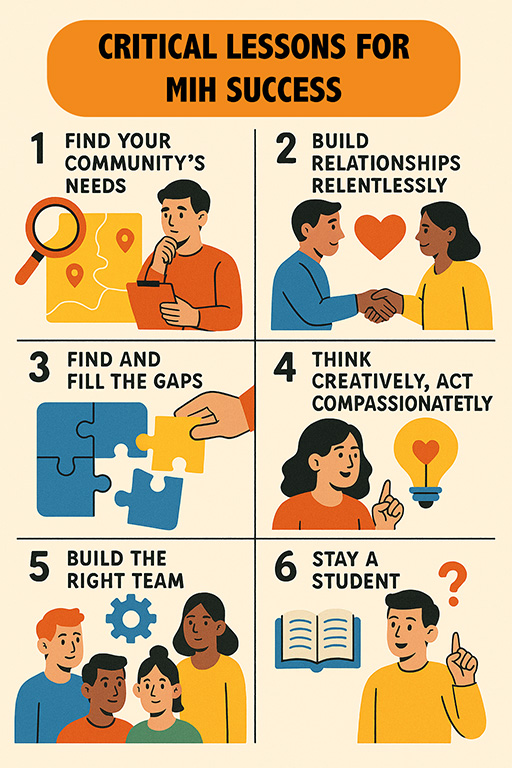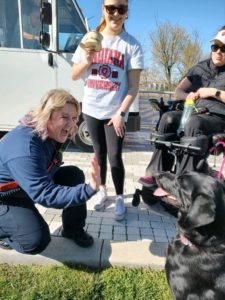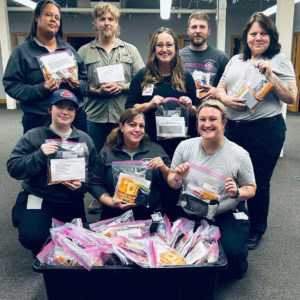From 911 to MIH – Six Critical Lessons
Starting Your MIH Journey – Inspiration from the Front Lines
If you’re about to embark on a Mobile Integrated Health (MIH) journey, welcome to one of the most innovative, challenging, and rewarding paths in community healthcare. To help new MIH managers take their first steps, Shelby VanDerMoere, MIH Program Manager for the  Bloomington Fire Department, gave an inspiring account of her own experience with MIH in a presentation at the Atrium Health Mobile Integrated Health and Community Paramedicine Conference. Along with Dr. Eric Yazel, Chief Medical Director for Indiana Emergency Medical Services (EMS), Shelby shared the key points behind her MIH program’s success, and the lessons she learned building that program from the ground up.
Bloomington Fire Department, gave an inspiring account of her own experience with MIH in a presentation at the Atrium Health Mobile Integrated Health and Community Paramedicine Conference. Along with Dr. Eric Yazel, Chief Medical Director for Indiana Emergency Medical Services (EMS), Shelby shared the key points behind her MIH program’s success, and the lessons she learned building that program from the ground up.
Find Your Community’s Needs
One of Shelby’s first and most important messages is this: know your community. There’s no one-size-fits-all blueprint for MIH programs; each community has its own needs, barriers, and opportunities. To make sure your MIH program fits your community, use tools like a Community Health Needs Assessment, get insights from your emergency department and EMS responders, and – last but not least – get feedback from patients themselves.
Shelby also gives a warning: don’t try to address all of your community’s needs right away. While it’s tempting to tackle every problem, it’s much better to identify a few key areas and focus on making a measurable impact. Until your program has proven itself in those areas, trying to expand further will likely spread your resources too thin.
As Dr. Yazel says, follow the old adage: better to do a great job with three things than a sloppy job with thirteen.
Build Relationships Relentlessly
Success in MIH doesn’t come from protocols alone—it’s born of relationships. Shelby encourages new programs to engage with every part of their community: hospitals, law enforcement, senior advocates, and more. By embedding her team’s presence with these community stakeholders, Shelby not only has an easier time getting help, but is better positioned to call immediate attention to recidivism in certain patient populations.
encourages new programs to engage with every part of their community: hospitals, law enforcement, senior advocates, and more. By embedding her team’s presence with these community stakeholders, Shelby not only has an easier time getting help, but is better positioned to call immediate attention to recidivism in certain patient populations.
Shelby also recommends keeping an open mind when building relationships. Anyone with their finger on the community’s pulse is worth reaching out to, including elected officials, churches, county fairs – even barbershops. Bloomington also uses social media, sharing their work in a way that not only reaches out to the community they serve, but also allows for engagement (and adds an air of levity).
Of course, some groups will be slow to accept a new MIH program, but Shelby still encourages reaching out. “You have no idea who you’re going to meet,” she says. “Just go out there and try. The worst they can do is tell you they don’t want anything.” And even when you get turned down, that may not be the end – in Shelby’s experience, many of the people who said no in the early days reached out later (sometimes years later) when they were finally ready to partner up.
Find and Fill the Gaps
MIH programs exist to fill the gaps in traditional healthcare. Dr. Yazel explained, “Every patient you encounter in EMS or the ED is some sort of failing of the overall healthcare system … even if it’s the most benign complaint, something out there led them to your doorstep.” Whether it’s caring for 911 high utilizers, offering support to unhoused individuals, or providing access to behavioral health services, Shelby’s team works to bridge the divide between what patients need and what other services provide. During her presentation, Shelby, Dr. Yazel, and even members of the audience shared heartbreaking stories of patients falling through the cracks. One frequent pattern was the referral loop, where a patient has needs that no one facility can fully cover – like a homeless person with chronic medical needs, or an expecting mother with substance use disorder. Rather than receiving partial care at one facility, the patient is endlessly shuttled between facilities and receives no care at all. MIH exists to help the people who suffer in situations like this.
During her presentation, Shelby, Dr. Yazel, and even members of the audience shared heartbreaking stories of patients falling through the cracks. One frequent pattern was the referral loop, where a patient has needs that no one facility can fully cover – like a homeless person with chronic medical needs, or an expecting mother with substance use disorder. Rather than receiving partial care at one facility, the patient is endlessly shuttled between facilities and receives no care at all. MIH exists to help the people who suffer in situations like this.
Not every gap is obvious, however, so Shelby’s team asks their patients: what do you wish would change about the healthcare system? What help did you look for, but not receive? This not only provides valuable information about gaps in their community’s healthcare, it also reassures the patient that the team cares about what’s gone wrong in the past. Building trust is critical in MIH, especially for patients who feel ignored or forgotten, and asking these questions is a great start.
Think Creatively, Act Compassionately
Since the problems they tackle already slipped past traditional care models, Shelby’s team specializes in creative and compassionate solutions. Some are simple gestures, like wrapping gifts for isolated seniors, or providing carbon monoxide detectors to vulnerable families. Other cases are trickier: in one instance, her team realized that some diabetic patients weren’t following their care plans because they were going without food in order to feed their pets. So, the team reached out to local pet food stores – who donated fifty-pound bags of cat and dog food.
The creative problem-solving doesn’t stop there. During a four-day power outage, Shelby’s team made the rounds to ensure that patients had coolers and ice packs for temperature-sensitive medicine. When a homeless patient refused admission to a winter shelter because they didn’t accept pets, her team arranged for temporary pet fostering. No matter what community need they’re focused on, Shelby and her team’s outside-the-box thinking helps them seek out the patients who’ve been overlooked and solve their problems – even if the solution is a bag of dog food.
Build the Right Team
Shelby’s MIH team grew from one to seven people in just two years. She sought out individuals with diverse skillsets, diverse backgrounds, and the drive to serve. While they have similar EMT training, Shelby recognizes and encourages their individual strengths – relying on one for grant writing, another for logistics, another for elderly chronic disease cases, etc. Some have additional training as social workers; some have more advanced medical training; some have peer support certifications, and the benefit of lived experience with the problems certain patients face.
Her advice? Don’t just fill positions with warm bodies – look for a passion to improve patients’ quality of life. Look for people who thrive in the unusual, creative, and deeply personal nature of MIH. Her team members may be unique, but this shared passion helps them work as one.
Stay a Student
Even with awards and recognition, Shelby’s team never stops learning. They engage in ongoing education, they collaborate with other MIH programs, and they keep an eye out for upcoming grants and other reimbursement opportunities. Shelby also recommends staying informed about legislation – both that which impacts the populations being served, and that which impacts EMS and MIH as a whole.
And of course, every patient encounter is an opportunity to learn. Watch for gaps in your own systems, listen to your patients’ feedback, and you’ll grow your understanding of the patient populations you serve.
Final Words
Shelby’s story is a testament to what MIH can be when led with heart, innovation, and persistence. If you’re just starting your MIH program, know this: the road ahead isn’t easy, but it’s filled with purpose. Seek out your community’s needs, reach out to the passionate people around you, never stop learning – and never be afraid to get creative when you’re helping someone in need.
Reference:
VanDerMoere, Shelby. “How Many Hoops Do I Have to Jump Through? Departments at the Start of Their MIH Journey.” Mobile Integrated Health and Community Paramedicine. 2025 Atrium Health’s Mobile Integrated Health and Community Paramedicine Clinical and Leadership Conference, 27 Mar. 2025, Savannah, Georgia.
